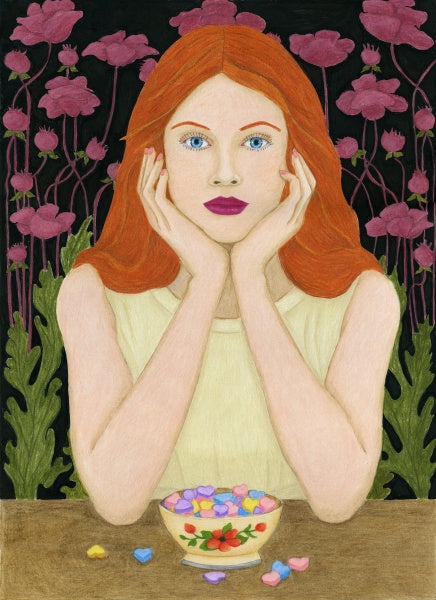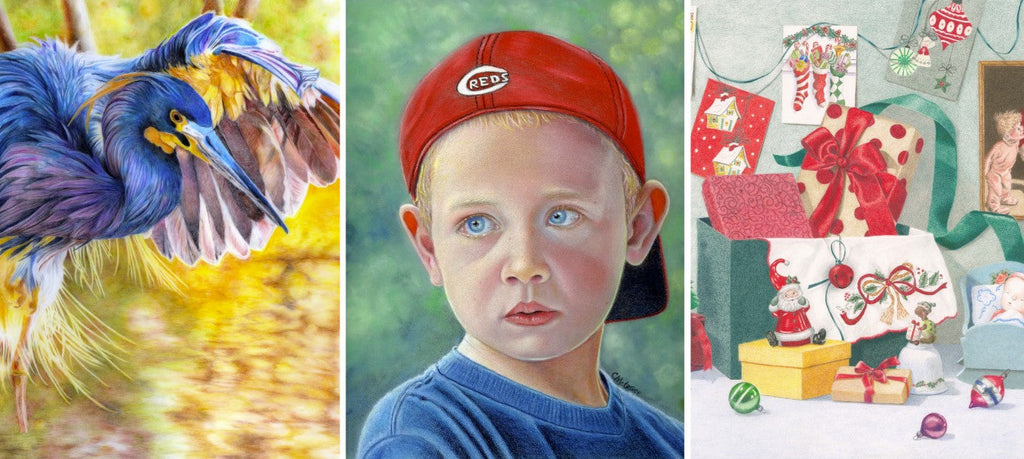My Journey Toward Drafting Film
by Susan Grimm
As a professional in the dental field since 1985, it was always my job to fix and make beautiful smiles with my hands. The problem was I rarely got to see the results of my hard work and artistic abilities if my patient went on to college, got married or just plain moved on in life. So, early on in my career, I promised myself I would someday become an artist and be able to create beautiful pieces of art that would give me and others joy and that I could place on the walls of my home.
In 2003, I began taking drawing classes on Saturday mornings where I learned about composition, negative spaces, using grids, the rules of thirds and even the golden ratio. I progressed to drawing portraits of my kids and my animals. I learned to flip my reference photo upside down to train my eye to draw what I saw and not what I thought I was seeing. This taught me to look at the shapes and colors first and not the face as a whole looking back at me.
"Bob's Chevy", Polychromos and Prismacolor on 12 x 12 Grafix matte two-sided film
My pieces took a long time to finish back then, and I thought I was good, but I always yearned to be better. So, in 2013, I signed up with Ann Kullberg for her five-day Super Workshop to learn more about drawing portraits with her colored pencil technique. This technique of hers concentrates on glowing skin tones and about 20 layers of Prismacolor pencils to achieve those natural skin tones. The first portrait I drew during her workshop was of my young niece up in a tree of cherry blossoms. Once I got to know Ann better, I followed her in her Color Magazine and across the country in other workshops she gave. As I began to meet other artists along the way, in person at workshops and on Facebook groups, I looked to them for additional advice on my pieces of art.
As years went on, I found the seasoned author and artist, Amy Lindenberger and I took her Color Theory class. With her instruction I was able to learn how to match hues, values and intensities in my artwork. As I created more and more pieces of art, I entered them into local art shows and, to my surprise, won several Best in Shows.
“The magic of drafting film is that it allows me to get to the fun part of any composition fast, because I can get to the deep rich colors without a lot of burnishing and layering of colors.”
Fast forward to 2020, when I learned about Graphix drafting film from a fellow artist and the way beautiful, realistic paintings could be achieved with colored pencils on this film. The magic of drafting film is that it allows me to get to the fun part of any composition fast, because I can get to the deep rich colors without a lot of burnishing and layering of colors. One’s mistakes are easily erasable, and colors seem to just pop off the surface of the film making your final product look like a photograph.
"Eye Candy" Polychromos and Prismacolor on 16 x 20 Grafix matte two-sided film
When purchasing drafting film please recognize that not all drafting films are the same. There is a Dura-lar film and a Graphix drafting film that is more professional grade. I love the Graphix matte, double-sided, .005” thick film from Dick Blick Art Store for my projects. The double-sided matte finish allows me to create depth of color on both sides of my film. To improve the intensity of color on the front of the film, I can add more of the same color or a different value on the back side of the film. This is especially useful with my backgrounds, my blacks and other dark colors in my composition. In my animal portraits, I can make the noses and the eyes deeper and richer by adding the same color on the reverse side. How cool!
The blending and smoothing of edges in my composition can easily be done on Graphix film with the use of paper stumps, and scrubber brushes, on a heated glass surface. Another way to smooth the look of my colors is to use odorless Turpenoid liquid with a tissue to smooth the color around on the film, prior to drawing over it. This comes in handy for backgrounds and large areas that require smooth color.
"Time to Reflect" Polychromos and Prismacolor on 16 x 20 Grafix, matte two-sided film
Finally, it is important to keep the Graphix film surface clean while working. The use of an artist’s glove (from Amazon) on your drawing hand, plus a sheet of waxed glassine paper will help prevent the smearing of your colors. Working on a sheet of glass under the film and using a draftsman brush will keep your area of work free of crumbs, lumps and irregularities. I usually select Prismacolors , Prismacolor Verithins or Faber Castell Polychromos as my pencils of choice. As I select my colors from these groups of pencils, it is important that I check their lightfastness to protect against fading over time. When finished, I spray my piece with four coats of matte UV Archival non-yellowing varnish, prior to framing with a museum tinted plexiglass.
“I promised myself I would someday become an artist and be able to create beautiful pieces of art that would give me and others joy and that I could place on the walls of my home.”
My most favorite pieces to draw lately are antique cars from car shows. I love the reflections in chrome, the horizontal and diagonal lines in grills and lights and the wide range of colors presented. Backgrounds are not always necessary because the cars are stunning by themselves. In this article I have included two of my recent classic cars from a local car show, (“Bob’s Chevy” and “Eye Candy”) and my favorite pocket watch photo (“Time to Reflect”) which demonstrates amazing details of mechanics and reflections. I hope you find your niche as I did and happy drawing everyone!
About Susan Grimm:
Susan Grimm is currently from Wooster, Ohio. She started drawing at a very young age. Then in 2003, Sue took up colored pencil classes to learn how to draw portraits. She honed her skills further by taking workshops about colored pencils, and color theory. Her style gravitates towards realism where she enjoys drawing classic cars, portraits and just colorful items. She has exhibited locally, nationally and was accepted into the Colored Pencil Society of America competitions in 2021 and 2022.
See more at: http://www.suegrimmart.com/





Comments (1)
Hi Ann Thank you for these tips! It is much appreciated. What is a heated glass surface?
Lara Mazzari - Aug 27, 2022